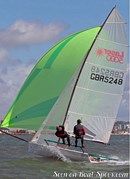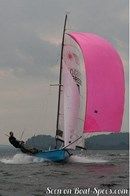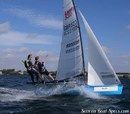Laser 5000
Sailboat specifications
The Laser 5000 is a 16’5” (5m) double handed skiff (dinghy) designed by Phil Morrisson (United Kingdom). She was built since 1992 (and now discontinued) by Laser Performance (United States).
Laser 5000's main features
- Model
- Laser 5000
- Hull type
- Monohull
- Category
- Double handed skiff (dinghy)
- Sailboat builder
- Sailboat designer
- Country
- United States
- Construction
- GRP (glass reinforced polyester):
- Hull: Single skin fiberglass polyester
- Deck: Sandwich fiberglass polyester - Number of hulls built
- About 300
- First built hull
- 1992
- Last built hull
- Discontinued
- Appendages
- Centerboard : daggerboard
- Helm
- Single tiller
- Rudder
- Single transom hung rudder
- Unsinkable
- No
- Trailerable
- Yes
- Standard public price ex. VAT (indicative only)
- N/A €
Laser 5000's main dimensions
- Overall length
- 24’ 11”7.6 m
- Hull length
- 16’ 5”5 m
- Beam (width)
- 10’3.05 m
- Draft
- 3’ 7”1.1 m
- Draft when appendages up
- 1’ 10”0.55 m
- Overall width folded
- 6’ 2”1.9 m
- Light displacement (MLC)
- 375 lb170 kg
Laser 5000's rig and sails
- Upwind sail area
- 224 ft²20.83 m²
- Downwind sail area
- 517 ft²48.03 m²
- Mainsail area
- 162 ft²15.03 m²
- Jib area
- 62 ft²5.8 m²
- Asymmetric spinnaker area
- 355 ft²33 m²
- Rigging type
- Sloop Marconi fractional
- Mast configuration
- Deck stepped mast
- Rotating spars
- No
- Number of levels of spreaders
- 1
- Spreaders angle
- Swept-back
- Spars construction
- Aluminum spars
- Standing rigging
- Continuous
Laser 5000's performances
- Crew
- 2
- Trapezes
- 2 set(s)
- PY (Portsmouth Yardstick) ratingiPortsmouth Yardstick is an empirical rating system allowing small sailboats (dinghies included), of different sizes and designs, to race each other fairly. Therefore, by comparing these values, we can have an indication of the relative speed of 2 boats.
- 846
- D-PN ratingiDPN is a variation of Portsmouth Yardstick used in the United States.
- 77.9
- Upwind sail area to displacementiThe ratio sail area to displacement is obtained by dividing the sail area by the boat's displaced volume to the power two-thirds.
The ratio sail area to displacement can be used to compare the relative sail plan of different sailboats no matter what their size.
Upwind: under 18 the ratio indicates a cruise oriented sailboat with limited performances especially in light wind, while over 25 it indicates a fast sailboat. - 731 ft²/T67.88 m²/T
- Downwind sail area to displacementiThe ratio sail area to displacement is obtained by dividing the sail area by the boat's displaced volume to the power two-thirds.
The ratio sail area to displacement can be used to compare the relative sail plan of different sailboats no matter what their size. - 1685 ft²/T156.51 m²/T
Laser 5000's auxiliary engine
- Engine(s)
- No engine
Laser 5000's accommodations and layout
- Cockpit
- Aft cockpit with racks


Laser Performance Laser 5000 - - 1/6
Picture extracted from the commercial documentation © Laser Performance
Picture extracted from the commercial documentation © Laser Performance


Laser Performance Laser 5000 - - 2/6
Picture extracted from the commercial documentation © Laser Performance
Picture extracted from the commercial documentation © Laser Performance


Laser Performance Laser 5000 - - 3/6
Picture extracted from the commercial documentation © Laser Performance
Picture extracted from the commercial documentation © Laser Performance


Laser Performance Laser 5000 - - 4/6
Picture extracted from the commercial documentation © Laser Performance
Picture extracted from the commercial documentation © Laser Performance


Laser Performance Laser 5000 - - 5/6
Picture extracted from the commercial documentation © Laser Performance
Picture extracted from the commercial documentation © Laser Performance


Laser Performance Laser 5000 - - 6/6
Picture extracted from the commercial documentation © Laser Performance
Picture extracted from the commercial documentation © Laser Performance
Similar sailboats that may interest you:
Sailboats
First built hull
Hull length
2001
15’ 8”4.8 m
1994
14’ 10”4.52 m
1995
13’ 1”4 m
2002
15’ 5”4.68 m
2001
13’ 11”4.25 m
1998
14’ 7”4.44 m
2014
13’ 10”4.2 m
2006
14’ 2”4.34 m
1994
16’ 4”4.98 m
2015
14’4.27 m
2009
13’ 11”4.23 m
2000
14’ 11”4.55 m
1995
15’ 2”4.64 m
2018
14’ 1”4.3 m
2017
14’ 1”4.3 m